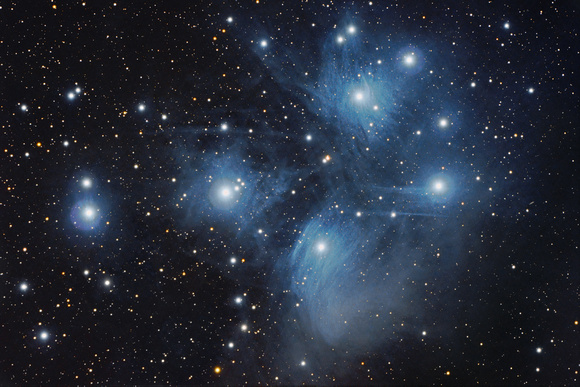Canon 350D Hap Griffin Baader Mod40x180sec at iso 1600
30 Darks/Flats/Bias
APM/TMB 130/780 with APM Field Flattener Yahoo Digital Astro Group November, 2008 Monthly Challenge Runner Up Perhaps the most famous star cluster on the sky, the
Pleiades can be seen without binoculars from even the depths of a
light-polluted city. Also known as the
Seven Sisters and M45, the Pleiades is one of the brightest and closest open clusters. The
Pleiades contains over 3000 stars, is about 400 light years away (among the closest open clusters to earth), and only 13 light years across. Quite evident in the image are the blue
reflection nebulae that
surround the brighter cluster
stars. Low mass, faint,
brown dwarfs have also
been found in
the Pleiades. (APOD)
The cluster is dominated by hot
blue stars, which have formed within the last 100 million years. Dust that forms faint
reflection nebulosity around the brightest stars was thought at first to be left over from the formation of the cluster but is now known to be an unrelated dust cloud that the stars are currently passing through. Many objects have been cataloged in this
busy region.
Astronomers estimate that the cluster will survive for about another 250 million years, when it will have dispersed due to gravitational interactions with the
spiral arms of the
galaxy and
giant molecular clouds.
Edge-on spiral UGC 2838 at magnitude 17.88 is visible to the right of M45. It is 300 million light years distant.
November 27, 2008


